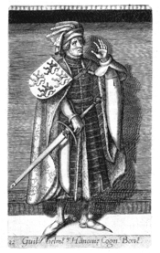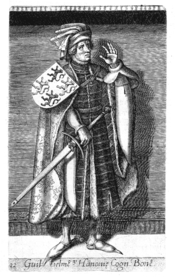
William I, Count of Hainaut
Encyclopedia

County of Holland
The County of Holland was a county in the Holy Roman Empire and from 1482 part of the Habsburg Netherlands in what is now the Netherlands. It covered an area roughly corresponding to the current Dutch provinces of North-Holland and South-Holland, as well as the islands of Terschelling, Vlieland,...
and Count William II of Zeeland
Zeeland
Zeeland , also called Zealand in English, is the westernmost province of the Netherlands. The province, located in the south-west of the country, consists of a number of islands and a strip bordering Belgium. Its capital is Middelburg. With a population of about 380,000, its area is about...
from 1304 to his death. He was the son of John II, Count of Hainaut and Philippa of Luxembourg
Philippa of Luxembourg
Philippa of Luxembourg was the daughter of Count Henry V of Luxembourg and his wife Marguerite of Bar. She married John II, Count of Holland...
William was originally not expected to become count but due to the death of his elder brothers John (killed at Kortrijk
Kortrijk
Kortrijk ; , ; ) is a Belgian city and municipality located in the Flemish province West Flanders...
in the Battle of the Golden Spurs
Battle of the Golden Spurs
The Battle of the Golden Spurs, known also as the Battle of Courtrai was fought on July 11, 1302, near Kortrijk in Flanders...
in 1302) and Henry (d. 1303) he became the main heir to his father's counties.
Before becoming count, he was defeated by Guy of Namur
Guy of Namur
Guy of Dampierre, Count of Zeeland, also called Guy of Namur , a younger son of Guy, Count of Flanders and Isabelle of Luxembourg, was Lord of Ronse....
at the battle on the island of Duiveland
Schouwen-Duiveland
Schouwen-Duiveland is a municipality and an island in the southwestern Netherlands.The Brouwersdam is a dam, part of the Delta Works, from Schouwen-Duiveland to Goedereede, the west part of the island of Goeree-Overflakkee in South Holland....
in 1304. Guy and Duke John II
John II, Duke of Brabant
John II van Brabant , also called John the Peaceful, was Duke of Brabant, Lothier and Limburg...
of Brabant
Duchy of Brabant
The Duchy of Brabant was a historical region in the Low Countries. Its territory consisted essentially of the three modern-day Belgian provinces of Flemish Brabant, Walloon Brabant and Antwerp, the Brussels-Capital Region and most of the present-day Dutch province of North Brabant.The Flag of...
then conquered most of Zeeland and Holland, but these territories were recovered again when William became the new count in the same year. William continued the war with Flanders
Flanders
Flanders is the community of the Flemings but also one of the institutions in Belgium, and a geographical region located in parts of present-day Belgium, France and the Netherlands. "Flanders" can also refer to the northern part of Belgium that contains Brussels, Bruges, Ghent and Antwerp...
until the peace of Paris
Paris
Paris is the capital and largest city in France, situated on the river Seine, in northern France, at the heart of the Île-de-France region...
in 1323, where the Count of Flanders
Count of Flanders
The Count of Flanders was the ruler or sub-ruler of the county of Flanders from the 9th century until the abolition of the position by the French revolutionaries in 1790....
denounced all claims on Zeeland.
William had occupied most of the bishopric of Utrecht and tried to conquer Friesland
Friesland
Friesland is a province in the north of the Netherlands and part of the ancient region of Frisia.Until the end of 1996, the province bore Friesland as its official name. In 1997 this Dutch name lost its official status to the Frisian Fryslân...
but was repelled by Hessel Martena
Hessel Martena
Hessel Martena was the tenth Potestaat of Friesland a province of the Netherlands...
. Many of his daughters married with important rulers of Europe and he was called the father in law of Europe. The King of England and the Holy Roman Emperor
Holy Roman Emperor
The Holy Roman Emperor is a term used by historians to denote a medieval ruler who, as German King, had also received the title of "Emperor of the Romans" from the Pope...
were married to his daughters, while he was married to the sister of the King of France. In spite of this, as an ally of the English King, he tried to gain support of surrounding counties and duchies for an anti-French coalition.
Internally, William restored order and founded new institutions, like the treasury and the chancellory. The council of the count got more responsibilities.
Family
He married Joan of Valois, sister of the future king Philip VI of FrancePhilip VI of France
Philip VI , known as the Fortunate and of Valois, was the King of France from 1328 to his death. He was also Count of Anjou, Maine, and Valois from 1325 to 1328...
, in 1305 and had the following children:
- William II, Count of HainautWilliam II, Count of HainautWilliam II, Count of Hainaut was William IV of Avesnes, William IV of Holland and William III of Zeeland from 1337 to his death, succeeding his father, William I. He married Joanna, Duchess of Brabant and Limburg in 1334, but had no issue.- Military career and death :William fought in France as...
(1307–1345) - John (died 1316)
- Margaret II, Countess of Hainaut (1311–1356), married Louis IVLouis IV, Holy Roman EmperorLouis IV , called the Bavarian, of the house of Wittelsbach, was the King of Germany from 1314, the King of Italy from 1327 and the Holy Roman Emperor from 1328....
, Holy Roman EmperorHoly Roman EmperorThe Holy Roman Emperor is a term used by historians to denote a medieval ruler who, as German King, had also received the title of "Emperor of the Romans" from the Pope... - Philippa of HainaultPhilippa of HainaultPhilippa of Hainault, or, Philippe de Hainaut was the Queen consort of King Edward III of England. Edward, Duke of Guyenne, her future husband, promised in 1326 to marry her within the following two years...
(1311–1369), married King Edward III of EnglandEdward III of EnglandEdward III was King of England from 1327 until his death and is noted for his military success. Restoring royal authority after the disastrous reign of his father, Edward II, Edward III went on to transform the Kingdom of England into one of the most formidable military powers in Europe... - Agnes (died 1327)
- Joanna of HainautJoanna of HainautJoanna of Hainault was the third daughter of William I, Count of Hainaut and Joanna of Valois. She was a younger sister of Philippa of Hainault, Queen of England, and Margaret II of Hainault...
(1315–1374), married William V, Duke of Jülich - Isabelle of Hainaut (1323–1361), married Robert of NamurRobert de NamurRobert of Namur, KG was a noble from the Low Countries close to King Edward III of England. He was made Knight of the Garter in 1369.His was the son of John I, Count of Namur, and Marie, Lady of Merode....
- Louis (1325–1328)

